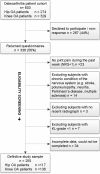Neuropathic-like symptoms and the association with joint-specific function and quality of life in patients with hip and knee osteoarthritis
- PMID: 29902245
- PMCID: PMC6002060
- DOI: 10.1371/journal.pone.0199165
Neuropathic-like symptoms and the association with joint-specific function and quality of life in patients with hip and knee osteoarthritis
Abstract
Objective: There is an association between osteoarthritis-related pain severity and function, yet clear evidence about the sole influence of neuropathic-like symptoms on joint function and health-related quality of life (HRQoL) is lacking. Previous studies among knee OA patients show an association between neuropathic-like symptoms, lower functional status and lower quality of life, however analyses were unadjusted or had limited adjustment for influential covariates like pain intensity. The aim of this study was therefore to determine the influence of neuropathic-like symptoms-adjusted for multiple influential covariates-on joint-specific function and HRQoL in hip and knee OA patients.
Methods: In this observational study 255 patients (117 with hip OA and 138 with knee OA) completed the modified painDETECT questionnaire (mPDQ) to identify subjects with neuropathic-like symptoms (mPDQ score>12, possible neuropathic pain [NP] phenotype). The WOMAC and the RAND-36 were used to asses respectively function and HRQoL. Results were adjusted stepwise for age, sex and BMI (Model 1); back disorder, painful body regions, comorbidities and previous surgery (Model 2); and pain intensity and analgesic usage (Model 3).
Results: A possible NP phenotype was experienced by 37% of hip and 46% of knee OA patients. Final model 3 analysis revealed that hip OA patients with neuropathic-like symptoms scored significantly lower on pain-related aspects of HRQoL (ΔRAND-36 bodily pain: 6.8 points, p = 0.047) compared to patients with the unlikely NP phenotype. In knee OA patients, a possible NP phenotype was associated with diminished joint function (ΔWOMAC domains ranging 7.1 to 10.5 points, p<0.05) and more deficits on the physical functional aspect of HRQoL (ΔRAND-36 physical functioning: 6.8 points, p = 0.016).
Conclusion: Neuropathic-like symptoms deteriorate the subjective rating of pain-related quality of life in hip OA patients and significantly influence function in knee OA patients.
Conflict of interest statement
The authors have declared that no competing interests exist.
Figures



Similar articles
-
History of knee surgery is associated with higher prevalence of neuropathic pain-like symptoms in patients with severe osteoarthritis of the knee.Semin Arthritis Rheum. 2014 Apr;43(5):588-92. doi: 10.1016/j.semarthrit.2013.10.001. Epub 2013 Oct 8. Semin Arthritis Rheum. 2014. PMID: 24188720
-
Obesity and increased burden of hip and knee joint disease in Australia: results from a national survey.BMC Musculoskelet Disord. 2012 Dec 20;13:254. doi: 10.1186/1471-2474-13-254. BMC Musculoskelet Disord. 2012. PMID: 23253742 Free PMC article.
-
Distribution of osteoarthritis in a Norwegian population-based cohort: associations to risk factor profiles and health-related quality of life.Rheumatol Int. 2017 Sep;37(9):1541-1550. doi: 10.1007/s00296-017-3721-6. Epub 2017 Apr 27. Rheumatol Int. 2017. PMID: 28451795
-
Systematic review and meta-analysis of the prevalence of neuropathic-like pain and/or pain sensitization in people with knee and hip osteoarthritis.Osteoarthritis Cartilage. 2021 Aug;29(8):1096-1116. doi: 10.1016/j.joca.2021.03.021. Epub 2021 May 8. Osteoarthritis Cartilage. 2021. PMID: 33971205
-
Results of total joint arthroplasty and joint preserving surgery in younger patients evaluated by alternative outcome measures.Dan Med J. 2014 Apr;61(4):B4836. Dan Med J. 2014. PMID: 24814600 Review.
Cited by
-
High Prevalence of Pain Sensitization in Knee Osteoarthritis: A Meta-Analysis with Meta-Regression.Cartilage. 2022 Jan-Mar;13(1):19476035221087698. doi: 10.1177/19476035221087698. Cartilage. 2022. PMID: 35356833 Free PMC article.
-
Neuropathic Pain Associated With First Metatarsophalangeal Joint Osteoarthritis: Frequency and Associated Factors.Arthritis Care Res (Hoboken). 2023 Oct;75(10):2127-2133. doi: 10.1002/acr.25125. Epub 2023 May 11. Arthritis Care Res (Hoboken). 2023. PMID: 37013633 Free PMC article.
-
Impact of preoperative factors on clinical outcomes after total hip arthroplasty.World J Orthop. 2025 Apr 18;16(4):105273. doi: 10.5312/wjo.v16.i4.105273. eCollection 2025 Apr 18. World J Orthop. 2025. PMID: 40290605 Free PMC article.
-
Chronic Pain in Musculoskeletal Diseases: Do You Know Your Enemy?J Clin Med. 2022 May 6;11(9):2609. doi: 10.3390/jcm11092609. J Clin Med. 2022. PMID: 35566735 Free PMC article. Review.
-
Assessment of Neuropathic Pain in Erosive Hand Osteoarthritis.J Clin Med. 2024 May 31;13(11):3244. doi: 10.3390/jcm13113244. J Clin Med. 2024. PMID: 38892955 Free PMC article.
References
-
- Cross M, Smith E, Hoy D, Nolte S, Ackerman I, Fransen M, et al. The global burden of hip and knee osteoarthritis: estimates from the global burden of disease 2010 study. Ann Rheum Dis. 2014;73: 1323–1330. doi: 10.1136/annrheumdis-2013-204763 - DOI - PubMed
-
- RIVM. Artrose→Cijfers & Context→Huidige situatie.2016. https://www.volksgezondheidenzorg.info/onderwerp/artrose/cijfers-context...
-
- WHO. Chronic rheumatic conditions. http://www.who.int/chp/topics/rheumatic/en/
-
- Fu K, Robbins SR, McDougall JJ. Osteoarthritis: the genesis of pain. Rheumatology. 2017. - PubMed
-
- Shigemura T, Ohtori S, Kishida S, Nakamura J, Takeshita M, Takazawa M, et al. Neuropathic pain in patients with osteoarthritis of hip joint. European Orthopaedics and Traumatology. 2011;2: 73–77.
Publication types
MeSH terms
LinkOut - more resources
Full Text Sources
Other Literature Sources
Miscellaneous

